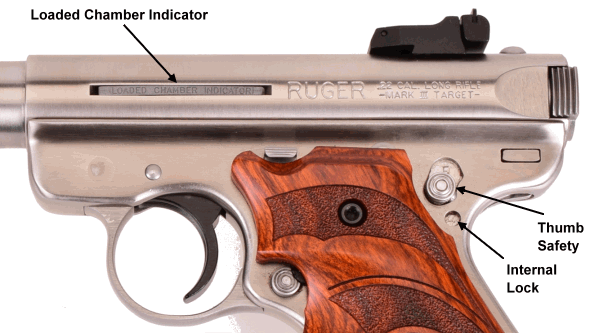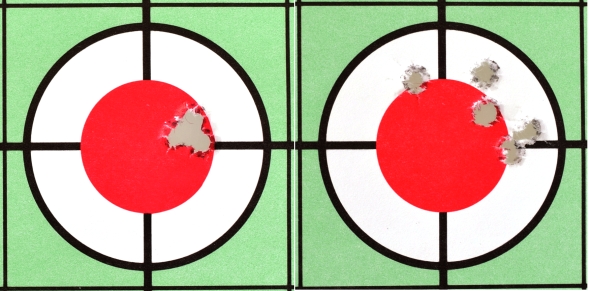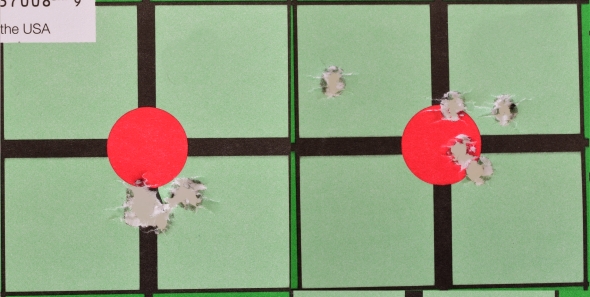
|
The Ruger Mark III Hunter represents one of those infrequent times when a firearm shoots as good as it looks. Joining the other fifteen models of Mark III and 22/45 type pistols, the Hunter is a heck of a pistol for taking small game, pest control or even just plinking.
Features distinguishing the Hunter from other model Mark IIIs are the combination of: fluted bull barrel, adjustable rear sights with fiber optic front sight, and target laminate grips. The stainless steel construction is a bit bright, but the finish softens naturally with use.
Packaged with the Hunter is a mini-canister of multiple replacement red and green Hi Viz light pipes with a “key” used to compress the light pipe retainer to facilitate change out.
The Hunter is drilled and tapped for optical sight mounting. To that end, the Hunter is supplied with a Weaver standard sight base which allows for the use of everything from dot reflex sights to magnifying long eye relief scopes.
Items packaged with the Ruger Mark III Hunter are pictured below. The small black key is for the pistol’s internal lock, its use is totally up to its owner.

For the sake of context, Versions Standard, II and III
For as much as I have always associated the Ruger brand with single action western style action revolvers, my first handgun was a Ruger Single Six Convertible, in 1949 Ruger and Sturm launched the company with a blow back 22 rimfire pistol, the Ruger Standard. That same original model persevered in numerous configuration until 1982 when it was displaced by the Mark II version.
The major evolutionary changes from the Standard to the Mark II were: a bolt stop to hold the bolt open when the last shot is fired with an empty magazine in place, magazine capacity was bumped to 10 rounds from 9 and the magazine latch was refined, a new safety designed allowed the pistol to be loaded or unloaded with the safety “on”, and the rear of the receiver was scalloped to facilitate grasping the bolt cocking lugs.
The major changes from the Mark II to the 2004 Mark III version are: one extra “I”, the magazine release was moved from the grip bottom to the frame’s left side, an visible and tactile loaded chamber indicator was added to the left side of the receiver, a key actuated internal lock was added, a magazine disconnector was added, and the sights and ejection port were re-contoured. This, according to some Internet message board denizens, is when Ruger entered into its well known contract with Beelzebub, the Price of Darkness, Lucifer, the Evil One as evidenced by the insidious inclusion of ever more safety devices.

It has become fashionable for some enthusiasts to morn the loss of early models of any firearms, condemn their replacements, then run to the nearest message board and bond over a good group cry. To participate, it is absolutely essential to ignore metallurgical advancements, brush aside vast refinements in manufacturing precision and process, disregard enhanced accuracy and reliability and, above all, express total distain for anything that enhances the safe use or storage of a firearm. What’s my point? The Mark III, as a minimum, is a refined version of the Mark II.
For folks who think the addition of a couple of parts will result in reduced reliability of an overall assembly with a critical mission, they might hold that thought for the next time they board a multi million part aircraft for a transcontinental flight. The Mark III has been in production now for a decade and the number of failures related to these new safety systems remains at zip.
Oh yeah… that whole shooting thing
When I was young I shot ten shot groups. As I got older I began shooting three shot groups to assure the highest possibility of an accurate read on a firearm’s accuracy before my mind drifted to thoughts of lunch and possibly a nap. So I ate lunch, took a nap and came out prepared to up my game to five shot groups. Everything was shot from a fixed rest and all with the open sights as supplied.

Remington Target 40 grain round nose rated at 1150 fps, actual average 953 fps. Left, 25 ft 3/8″ group, right 25 yards 1″ group.

Remington Golden Bullet Round Nose 40 grain rated at 1255 fps, actual average 1052 fps. Left, 25 ft 7/16″ group, right 25 yards 1 1/4″ group.

Remington Cyclone HP 36 grain rated at 1280 fps, actual average 1208 fps. Left, 25 ft 3/4″ group, right 25 yard 1 3/8″ group.
The three groups above were the best from an assortment of CCI, Eley, Federal, Winchester, and other Remington ammo. The worst performance came from Federal Champion Target 36 grain ammo, 5/8″ at 25 ft, which opened to 2 1/2″ at 25 yards.
Old and new…
It usually takes me a while to shoot a pistol well… or gooder. I need to crack my knuckles, stretch my fingers, pick it up, complain about the sights, complain about its lack of natural point… have lunch, grouse some more, shoot a few mediocre groups, blame it on the… anything but me. Then I sit down in front of my computer, go to the Brownells site and purchase enough custom parts to replace at least 70% of the pistol’s parts. Two weeks are then dedicated to waiting for parts and sitting at the bench and installing whatever arrives. THEN I shoot a few thousand rounds learning how to shoot the pistol correctly. Of course, it is quite possible that the real improvement came from practice.

I did take the opportunity to compare the current Ruger Mark III Hunter with my own Mark III Target, a pistol that had been heavily tweaked, finessed, modified, and massaged until it feels exactly right for me. From a fixed rest, they shot about the same, but then the barrel and bolt in my Target is approximately the same as those pieced in the Hunter. The Laminated Target grip on the Mark III Hunter was very comfortable and very stable shooting off hand or rested. If my Mark III Target held an edge it was in one or two handed shooting without support. But then I have about $200 and about 6 hours in labor invested into my Target’s trigger, hammer and sear to make it light, short stroked and overtravel free. The Mark III Hunter’s trigger is crisp, however, it is a bit on the heavy side.
Overall…

The Ruger Mark III Hunter is a quality pistol capable of a high degree of accuracy, consistency and reliability. Not once during any of the live fire efforts did the Ruger fail to cycle properly or fail to fire and every velocity type of ammo was shot from subsonic to hypervelocity.
Mechanical accuracy is there, right out of the box, so the issue becomes one of practice as I am sure the heavier trigger pull is manageable with a little bit of range time. Nice pistol.

Email Notification